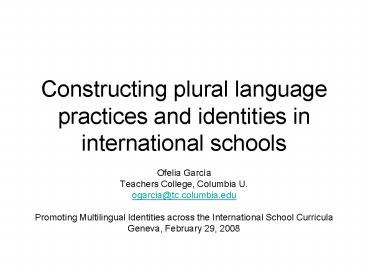Constructing plural language practices and identities in international schools - PowerPoint PPT Presentation
1 / 24
Title:
Constructing plural language practices and identities in international schools
Description:
Promoting Multilingual Identities across the International School Curricula ... Bil Boy: Right Ms. T. que snowball es nieve bola? 5th grade. Self-contained classroom ... – PowerPoint PPT presentation
Number of Views:170
Avg rating:3.0/5.0
Title: Constructing plural language practices and identities in international schools
1
Constructing plural language practices and
identities in international schools
- Ofelia García
- Teachers College, Columbia U.
- ogarcia_at_tc.columbia.edu
- Promoting Multilingual Identities across the
International School Curricula - Geneva, February 29, 2008
2
Subtractive bilingualismHome language
School language
3
Additive bilingualismHome language
School language
4
Dynamic bilingualism
5
Dynamic Bilingualism Plurilingualism
- The ability to use several languages to varying
degrees and for distinct purposes - An educational value that is the basis of
linguistic tolerance.
6
Dynamic bilingualism at the center
- Challenging venerable assumptions
- The emergent bilingual, rather than the second
language learner - Home languages and additional languages, rather
than L1 and L2
7
Poly-directional dimensions in international
schools
- Different home languages
- Different proficiencies in the languages of
school instruction - Different proficiencies in the languages of the
societal context
8
Poly-directional dimensions in international
schools
- Multiple home languages X, Y, Z
- Multiple points in language of instruction
- LIa, LIb, LIc, LId, LIe, LIf, LIg..
- Multiple points in language of society
- LSa, LSb, LSc, LSd, LSe, LSf, LSg..
9
Schools
- Insist on static notion of language as autonomous
skill - Recognize bilinguals only as two monolinguals
- Insist on instruction that is monolingual and
static, even when bilingual - Language separation is good
- Code-switching is bad
- Violates a diglossic language separation
- Leads to language shift
10
Poly-directional bilingual classrooms
- Must recognize the multiple discursive practices
of students with different languaging
experiences and build upon them - Must see translanguaging as an important and
legitimate practice
11
Translanguaging practices exist in families
- The family meal as a translanguaging event
- Television as a translanguaging event
12
Childrens uses of translanguaging
- To co-construct understandings (conceptual and
linguistic) - with each other
- with each language
- To include everyone
- To mediate understandings
13
Examples from U.S. two-way (Dual language)
classrooms
- Not two-way except in name. They are
poly-directional - Recently arrived children
- Multiply recently arrived
- Multiple generations
- Mixed marriages and divorces
- Not dual except in name. There is much
translanguaging
14
Kindergarten side-by-side Integration and
Separation
15
Translanguaging to co-construct
- Three Spa-speaking children, different bilingual
ranges, writing/drawing in English journals - A. Looking out the window and talking to
himself - Está lloviendo mucho.
- Look telling the others Its washing
there. - Theres washing afuera.
- G. Está lloviendo? She asks him
- Turning to me He says raining. He speaks
Spanish, only Spanish. - Turning to boy Adolfo, raining.
- A. Raining
16
Translanguaging to co-construct
- Children are describing a tree outside. Im
sitting next to Latina Spanish speaker - Teacher This tree is bigger. That tree is
smaller - Girl Tries out under her breath
- This tree is grander.
17
Translanguaging to include
- Two Spanish speaking children, a boy and a girl,
are playing blocks in Spanish. An African
American girl, comes in - EngG Are you done?
- SpaB Yes, I done starts walking away
- BilG To the Eng speaking girl
- Do you want to play with us?
- The three start playing
18
Translanguaging to mediate Children as
translators
- Teacher Im getting angry at youto SpaSpkr
- Bil Boy Qué tienes que escuchar a la
maestra, Yolanda! - That you have to listen to the
teacher, Y - Teacher Sit up!
- Bil Boy In Spanish, its siéntate arriba!
- Eng Girl How do you say snowball in Spa?
- Bil Boy Right Ms. T. que snowball es nieve
bola?
19
5th grade
- Self-contained classroom
- Spanish in morning English in afternoon
- Only one recently arrived and not bilingual
20
Translanguaging to co-construct
understandings
- Teacher lectures in one language, students take
notes in another - Students read in one language but discuss in
another - Students read in one language and write in
another - Sticky notes.
21
5th grade Social Studies test as translanguaging
event
- Learning Social Studies Separation
- in Spanish in A.M.
- Testing Social Studies Trigger
- in Spanish or English
- All will have both tests
- All in English except newly arrived
22
5th grade Social Studies test
- Review for test Translanguaging
- Review with English versions
- Spanish speaking child follows with Spanish
version - Most Discussion in English
- Translations for Spanish speaking child
- Occasional looking up of notes and readings in
Spanish. Discussion changes to Spanish - Writing in English referring to material written
in Spanish
23
Translanguaging in classrooms
- Mixes discursive practices modalities
- Builds intercultural spaces
- Maximizes communication
- Develops critical linguistic awareness and
linguistic tolerance
24
Poly-directional bilingual pedagogy must
- Build on translanguaging
- Value translanguaging as important in 21st
century - Use translanguaging to incorporate into
linguistic repertoire standard ways of using
dominant languages































